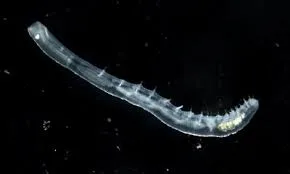INTERESTING FACTS ABOUT EARTHWORMS

1. An earthworm is a tiny, long, thin animal that lives in the dirt and has neither legs nor eyes.
2. Worms Don’t Have Lungs and Breathe Through Their Skin.
All living things require oxygen to function. Worms are unable to breathe via their mouths because they lack a nose. Instead of lungs, worms have a thin layer of permeable skin that allows oxygen from the air to pass through. On a worm’s epidermis, mucus breaks down oxygen. As a result, there has to be enough moisture in the worm bin. If a worm becomes dry, it suffocates. Worms drown in extremely damp settings, much like people do.
3. Worms Are Cold Blooded and Have 5 Hearts.
Worms cannot adjust their body temperature like mammals do because they have chilly blood. This implies that their body temperature will match that of their environment.
In contrast to mammals and reptiles, worms do not have a heart with several chambers. Instead, they have five single-chambered aortic arches that pump blood throughout their bodies in a manner like a heart. The worm’s head is not far from the five hearts.
4. A worm can live up to 8 years, however, the average life span is only about 2 years.
Worms have a wide range of life spans, depending on the species. In a secure, stable habitat, certain worm species can live for up to 4–8 years. There are several worm predators in nature. A composting worm normally lives for two to three years.
5. South African-born Microchaetus rappi is the world’s longest earthworm.

The longest earthworm is a South African species called Microchaetus rappi. In 1967, a large specimen measuring 20 mm (0.8 in) in diameter and 6.7 m (21 ft) long when stretched was found on a road between Alice and King William’s Town.
6. The Chaetogaster Annandale is the shortest earthworm.

With a length of less than 0.5 mm (0.02 in), Chaetogaster Annandale is the shortest earthworm.
7. About 6,000 Different Types of Earthworms Exist.
All continents except Antarctica have worms. Earthworms come in roughly 6,000 different species. The invasive species of earthworms. The soil ecology might change in many different ways as a result of their arrival.
8. They travel underground by tightening their body muscles.
The bulk of an adult is 10 times their own weight in strength. They move like a tube inside a tube when various muscles alternately shrink and extend their body. Different muscles contract and relax to produce this movement.
They have the capacity to produce mucus, which facilitates their ability to float through the ground when digging.
9. Most of them are hermaphrodites.
The majority of earthworms are hermaphrodites, which means they possess both the male and female worms’ sex organs. This method of reproduction is really amazing and practically doubles the benefits of mating because both partners may exchange genetic material and pass it on.
However, because some of these copulations might endure for up to 200 minutes, it’s advisable to make the most of the circumstances.
10. They consume trash! from the soil.
As they fall off in the fall or when we compost our vegetable scraps, plant leaves gradually deteriorate. We almost take it for granted since it occurs so regularly, yet the process is still in motion.
Among the numerous creatures and microbes involved in this process, earthworms are one of the most crucial. Without them, objects like leaves would just lie on the ground. Earthworms adore eating this, which is what we often refer to as leaf litter.
11. Earthworms modify soil.
Earthworm burrows mix soil layers, aerate the substrate, and decompose complex organic compounds to generate the nutrient-rich excrement that lies on the soil’s surface and is easily accessible to plants. Additionally, this avoids soil erosion and supports the structural integrity of the plant-growing medium.
As a result, they are crucial to the growth of our plants and food. Without earthworms, soil compaction would increase over time, reducing the ability of roots to breathe and absorb water.
12. Reproduction
Since they have both male and female gametes, earthworms are hermaphrodites. Both worms exchange sperm and have their eggs fertilized during mating. A clitellum is the term for the inflated, belt-like region on an earthworm’s body that is sometimes referred to as a “saddle” or “belt.” It secretes a sticky fluid that hardens into capsules that shield the eggs, where sperm and eggs combine to make embryos. One to twenty eggs mature within, and depending on the humidity and temperature of the surrounding environment, it might take 60 to 90 days for them to hatch. Adult earthworms can take up to a year to develop, and they can survive up to 8 years in the wild.
13. Allolobophora chlorotic sometimes referred to as the “green worm,”.

A kind of earthworm called Allolobophora chlorotic sometimes referred to as the “green worm,” lives and feeds in the dirt. The three pairs of sucker-like discs on the underside of the clitellum distinguish this species from other earthworms.
14. Rhinodrilus alatus earthworm.

The giant earthworm Rhinodrilus alatus is indigenous to the Brazilian Cerrado hotspot and has been used as live bait for nearly 80 years.
15. Siebold’s earthworm.

Kantaro is the scientific name for a huge earthworm called Pheretima sieboldi (Horst. ), which is a member of the Futomimizu rope family of Annelida Oligochaeta.
Share this content:
Post Comment